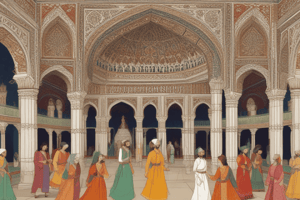Podcast
Questions and Answers
What were the prominent contributions of the Chola dynasty during the early medieval period?
What were the prominent contributions of the Chola dynasty during the early medieval period?
- Expansion of trade and temple architecture (correct)
- Invention of the printing press
- Development of advanced mathematics and astronomy
- Establishment of the Delhi Sultanate
Which dynasty is associated with the introduction of economic policies during the late medieval period?
Which dynasty is associated with the introduction of economic policies during the late medieval period?
- Slave Dynasty
- Khilji Dynasty
- Mughal Dynasty
- Tughlaq Dynasty (correct)
What major event marked the founding of the Mughal Empire?
What major event marked the founding of the Mughal Empire?
- The assassination of Ibrahim Lodi
- The Treaty of Lahore
- The First Battle of Panipat (correct)
- The Second Battle of Tarain
Which Mughal emperor is acclaimed for his architectural achievement of commissioning the Taj Mahal?
Which Mughal emperor is acclaimed for his architectural achievement of commissioning the Taj Mahal?
Which cultural movements emphasized personal devotion and spirituality during the Indian medieval period?
Which cultural movements emphasized personal devotion and spirituality during the Indian medieval period?
What were significant factors contributing to the decline of the Indian medieval period?
What were significant factors contributing to the decline of the Indian medieval period?
What is 'Ain-i-Akbari' known for?
What is 'Ain-i-Akbari' known for?
Which of the following was a characteristic of socio-economic conditions during the Indian medieval period?
Which of the following was a characteristic of socio-economic conditions during the Indian medieval period?
Flashcards are hidden until you start studying
Study Notes
Overview of the Indian Medieval Period
- Timeframe: Roughly 8th to 18th centuries.
- Division: Early (8th-12th centuries) and Late Medieval Period (13th-18th centuries).
Early Medieval Period (8th-12th centuries)
- Rise of regional kingdoms following the decline of the Gupta Empire.
- Key Dynasties:
- Rashtrakutas: Noted for cultural contributions and architecture.
- Cholas: Expanded trade, renowned for temple architecture and bronze sculptures.
- Pallavas: Influential in South India, famous for rock-cut temples.
Late Medieval Period (13th-18th centuries)
- Marked by the establishment of Islamic rule and the emergence of the Delhi Sultanate.
- Key Dynasties of the Delhi Sultanate:
- Slave Dynasty (1206-1290): Founded by Qutb al-Din Aibak.
- Khilji Dynasty (1290-1320): Notable for territorial expansion.
- Tughlaq Dynasty (1320-1414): Introduced significant economic policies and architectural achievements.
Mughal Empire (1526-1857)
- Founded by Babur after defeating Ibrahim Lodi in the First Battle of Panipat.
- Key Mughal Emperors:
- Akbar (1556-1605): Promoted religious tolerance and administrative reforms.
- Jahangir (1605-1627): Known for patronage of arts and culture.
- Shah Jahan (1628-1658): Commissioned the Taj Mahal, marked by architectural grandeur.
- Aurangzeb (1658-1707): Expanded the empire to its greatest territorial extent, faced large-scale rebellions.
Cultural Developments
- Flourishing of arts, literature, music, and architecture.
- Bhakti and Sufi movements emerged emphasizing personal devotion and spirituality.
- Introduction of Persian and Urdu languages influenced literature and culture.
Socio-Economic Conditions
- Agriculture remained the backbone of the economy.
- Trade expanded across regions; significant coins and trade routes developed.
- Emergence of urban centers focused on crafts and commerce.
Decline of the Medieval Period
- Factors for decline included:
- Fragmentation of power among regional kingdoms.
- Invasions (e.g., from the Marathas and later the British).
- Internal conflicts and rebellions.
- Marked by the rise of British colonial power in the 18th century.
Important Historical Texts
- "Ain-i-Akbari" by Abu'l-Fazl: A detailed account of Akbar's reign and administration.
- "Tuzk-e-Jahangiri": Memoirs of Jahangir, providing insight into his rule.
Conclusion
- The Indian medieval period was characterized by significant political, cultural, and economic developments.
- It laid the foundation for the emergence of modern India, influencing its future socio-political landscape.
Indian Medieval Period Timeline
- Roughly 8th to 18th centuries
- Divided into Early (8th-12th centuries) & Late Medieval Period (13th-18th centuries)
Early Medieval Period (8th-12th centuries)
- Regional kingdoms rise after the Gupta Empire's decline
- Key Dynasties:
- Rashtrakutas: Known for cultural contributions & architecture
- Cholas: Expanded trade, famous for temple architecture & bronze sculptures
- Pallavas: Influential in South India, recognized for rock-cut temples
Late Medieval Period (13th-18th centuries)
- Islamic rule establishment, emergence of Delhi Sultanate.
- Key Dynasties of the Delhi Sultanate:
- Slave Dynasty (1206-1290): Founded by Qutb al-Din Aibak.
- Khilji Dynasty (1290-1320): Known for territorial expansion
- Tughlaq Dynasty (1320-1414): Introduced key economic policies, notable for architectural achievements
Mughal Empire (1526-1857)
- Founded by Babur after defeating Ibrahim Lodi at First Battle of Panipat
- Key Mughal Emperors:
- Akbar (1556-1605): Promoted religious tolerance & administrative reforms
- Jahangir (1605-1627): Famous for patronage of arts & culture
- Shah Jahan (1628-1658): Commissioned the Taj Mahal, known for architectural grandeur
- Aurangzeb (1658-1707): Expanded the empire to its greatest territorial extent, faced large rebellions
Cultural Developments
- Flourishing of arts, literature, music, & architecture
- Bhakti & Sufi movements emerged, emphasizing personal devotion & spirituality
- Introduction of Persian & Urdu languages influenced literature & culture
Socio-Economic Conditions
- Agriculture remained the backbone of the economy
- Trade expansion across regions, notable coins & trade routes developed
- Emergence of urban centers focused on crafts & commerce
Decline of the Medieval Period
- Key factors for decline:
- Fragmentation of power among regional kingdoms
- Invasions (e.g., Marathas, British)
- Internal conflicts & rebellions
- Rise of British colonial power in the 18th century
Important Historical Texts
- "Ain-i-Akbari" by Abu'l-Fazl: Detailed account of Akbar's reign & administration
- "Tuzk-e-Jahangiri": Memoirs of Jahangir, providing insight into his rule
Conclusion
- Indian medieval period marked by significant political, cultural & economic developments
- Laid the foundation for modern India, influencing its future socio-political landscape
Studying That Suits You
Use AI to generate personalized quizzes and flashcards to suit your learning preferences.




